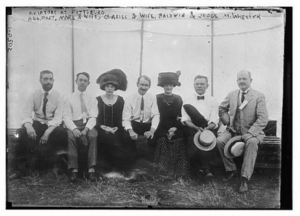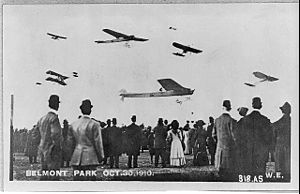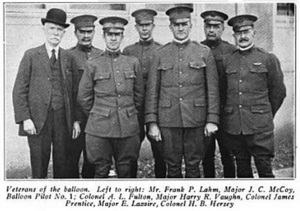Aero Club of America facts for kids
The Aero Club of America was a special club created in 1905. People like Charles Jasper Glidden and Augustus Post started it. Their main goal was to help aviation, or flying, grow in America. This club was like the main office for many smaller flying clubs across the country. The first of these was the Aero Club of New England.
The Aero Club of America was very active until 1923. Then, it changed into the National Aeronautic Association, which is still around today. This club was the first to give out pilot's licenses in the United States. Until 1914, the U.S. Army required its pilots to get their licenses from this club. The Aero Club also organized many exciting air shows and flying contests. In 1910, Cortlandt Field Bishop was the president. A year later, the new president, Robert J. Collier, started giving out the famous Collier Trophy for achievements in aviation.
Contents
History of the Aero Club
Many people think the Aero Club started in 1905. However, there are older photos from 1902 that already have "Aero Club" stamped on them. In the summer of 1905, several members of the Automobile Club of America decided to create a new club. These members included Charles Glidden, Homer Hedge, Dave Morris, John F. O'Rourke, and Augustus Post.
They loved flying in balloons but felt there wasn't enough support for aviation as a sport in America. So, they decided to form a new club. It was similar to the Automobile Club but focused on promoting flying, much like the Aero Club of France. Homer Hedge became the first president, and Augustus Post was the first secretary.
In 1910, different flying clubs and groups met in New York. They formed the National Council of Affiliated Clubs of the Aero Club of America. Thirty-nine representatives from places like Pasadena, California, and Boston met. They created the main organization for all the state flying clubs.
Controversy at the Belmont Park Air Meet
At the International Aviation Meet at Belmont Park in October 1910, a big disagreement happened. It was between an English pilot named Claude Graham-White and an American pilot named J. B. Moisant. In one race around the Statue of Liberty, Graham-White finished several minutes faster. But because of a small rule, the race and a large prize were given to Moisant.
John Armstrong Drexel, another pilot, publicly said the club was unfair. He accused them of favoring their own members. Drexel even held his own dinner party at the same time as the club's awards banquet. This disagreement caused problems among the members. It threatened to split the organization. However, the issue was solved when Drexel resigned from the club.
First Industrial Airplane Show
In 1911, the Aero Club of New York put on the First Industrial Airplane Show. This event happened alongside the 11th U.S. International Auto Show. It took place at Manhattan's Grand Central Palace in New York City. It was a fantastic event with important speakers. A large, excited crowd came to see a full-size airplane for the very first time. The show started on December 31, 1910, and lasted until mid-January 1911.
The Orteig Prize
In 1919, the club's secretary, Augustus Post, helped create the rules for a transatlantic flight competition. This was a race to fly across the Atlantic Ocean between New York and Paris. He worked with a rich hotel owner named Raymond Orteig to get the $25,000 prize money. The Orteig Prize was for "the first aviator of any Allied Country crossing the Atlantic in one flight, from Paris to New York or New York to Paris."
For five years, no one tried to win the prize. Then, the award was put under the control of a group of trustees. In 1927, they awarded it to Charles Lindbergh. He successfully flew across the Atlantic in his plane, the Spirit of St. Louis.
National Aeroplane Fund
The Aero Club of America supported the National Aeroplane Fund. This fund was created in the summer of 1915. It was a response to the feeling that the military and politicians weren't interested enough in aviation. The group worked to convince Congress to spend more money on military aviation.
The fund's goal was to train pilots. It also aimed to provide airplanes for the National Guard and Navy Militia in different states. They wanted to use planes for mail delivery to hard-to-reach places. This would create a group of trained pilots and planes. These could be used daily for peaceful purposes but also be ready for military service if needed.
In July 1915, Alan Hawley, the president of the National Aeroplane Fund, wrote a letter. It described flight demonstrations planned for the Vermont National Guard. The fund provided the airplane and pilot for this test. The pilot was an early aviator named George A. Gray.
The letterhead of this fund shared important information. It stated that the U.S. Army and Navy together had fewer than twenty planes. Only a few licensed U.S. pilots had flown more than fifty miles. Also, the Army, Navy, and National Guard had no experience working with aircraft.
The letter compared the U.S. situation to other countries. England had 1,500 airplanes and pilots. Germany and France had built large air fleets. They did this mostly through public donations and interest. For example, in 1912, France started a public collection. This brought in over 6 million francs and gave France 208 airplanes. It also provided 62 landing spots and 75 trained pilots. This public interest made the French government pay attention to aviation needs. By April 1914, the French Army had 1,200 airplanes and 28 airships.
Germany's air fleet was also built by public donations. Their Aerial League started a collection in 1912. It raised over 7 million marks. The League wanted to train many pilots quickly to form a reserve. They also wanted to encourage aviation in Germany. By the end of 1913, Germany had 600 pilots, up from 230 in 1912. The number of airplane makers also grew. These efforts led the German government to plan spending $35 million on military aviation.
In early 1914, German pilots broke many world records. Reinhold Boehm flew for 24 hours and 12 minutes without stopping. Heinrich Oelrich reached an altitude of 26,246 feet. Otto Linnekogel reached 21,654 feet, which is almost as high as Mount McKinley! Just like in France and Germany, people in America could unite to support aviation.
Notable Licensed Pilots
Here are some important early pilots who received licenses from the Aero Club of America.
Airplane Division Pilots
- 01 Glenn Curtiss
- 02 Frank Purdy Lahm
- 03 Louis Paulhan, a French pilot
- 04 Orville Wright (honorary license)
- 05 Wilbur Wright (honorary license)
- 06 Clifford B. Harmon
- 07 Thomas Scott Baldwin (1854–1923)
- 08 John Armstrong Drexel
- 09 Todd Shriver
- 10 Charles Foster Willard
- 11 James Cairn Mars (1875–1944)
- 13 Leon Richardson (1887-1951)
- 17 Eugene Ely
- 24 Charles Terres Weymann
- 25 Augustus Post
- 26 Ralph Clayton Diggins (1887–1959). He was born in Michigan and moved to Chicago. He first flew in 1912. He was the 26th person in the U.S. to get a pilot's license from the Aero Club of America.
- 28 Theodore Gordon Ellyson
- 32 Edson Fessenden Gallaudet
- 35 William Redmond Cross, a Governor of the Aero Club of America from 1911 to 1921
- 37 Harriet Quimby, the first woman pilot

- 44 Matilde Moisant, the second woman pilot

- 55 Norman Prince, an early member of the Lafayette Escadrille flying group
- 57 Paul Peck, one of the first U.S. Army pilots
- 133 Julia Clark, the third woman pilot

- 148 Katherine Stinson (1891–1977), the fourth woman pilot
 . She convinced flight instructor Max Lillie to teach her in 1912. Katherine became a famous stunt pilot.
. She convinced flight instructor Max Lillie to teach her in 1912. Katherine became a famous stunt pilot. - 164 Walter Johnson (1888-1961), a test pilot for Thomas Brothers and Glenn Curtiss.
- 173 Bernetta Adams Miller, the fifth woman pilot

- 188 Ruth Bancroft Law, also known as Ruth Law Oliver, the sixth woman pilot

- 303 Marjorie Stinson (Katherine's sister), the ninth licensed female pilot in the United States

- 354 Albert Daniel Smith (1887-1970)
- 440 Reginald Malcolm, a World War I flying ace
Seaplane (Hydroaeroplane) Division Pilots
- 01 Adolph G. Sutro
- 02 Lieutenant Alfred Austell Cunningham (USN)
- 03 Lieutenant B. B. Smith (USN)
- 04 Lieutenant Commander Patrick Nieson Lynch Bellinger (USN)
- 05 Ensign Godfrey DeCourcelles Chevalier (USN)
- 06 Logan Archbold Vilas
- 07 William Ellwood Doherty
- 08 H. P. Harris
- 09 Ernest C. Bass
- 10 Steve MacGordon
- 26 Roger Weightman Jannus (1886-1918)
Balloon Division Pilots
- 01 Major James C. McCoy (USA)
- 02 Albert Leo Stevens
- 03 Frank Samuel Lahm
- 04 Colonel Frank Purdy Lahm (USA)
- 05 Carl E. Meyers
- 06 Colonel Henry B. Hersey (USA)
- 07 Allan R. Hawley
- 08 Colonel Charles deForest Chandler (USA)
- 09 Thomas Scott Baldwin (1854–1923)
- 10 Albert C. Triaca
- 11 Augustus Post
- 27 Sylvester Louis Von Phul (1878–1911)
- 533 Harry Rasmussen (1886–1968)
Airship (Dirigible) Division Pilots
Note: A "Dirigible" is an airship that can be steered in any direction.
- 01 Major Thomas Scott Baldwin (1854–1923)
- 02 Brigadier General Frank Purdy Lahm (1887-1963)
- 03 Captain Horace Bird Wild (1879-1940)
- 04 Augustus Roy Knabenshue (1875-1960)
- 05 Albert Leo Stevens (1877-1944)
- 06 Frank W. Goodale
- 07 Ralph Hazlett Upson (1888-1968)
- 08 Ralph Albion Drury Preston (?-1954)
- 09 Walter J. Pouchot
- 10 Noel Chadwick
Presidents of the Aero Club
- Charles Jasper Glidden 1905 to 1910
- Cortlandt Field Bishop 1910 to 1913
- Alan Ramsay Hawley 1913 to ?
- Jonathan Gaffney 2007 to present
See also
- Other Aero clubs
- National Aeronautic Association, the club that took over from the Aero Club of America (1922)
- Aéro-Club de France (1898)
- Royal Aero Club (1901)





